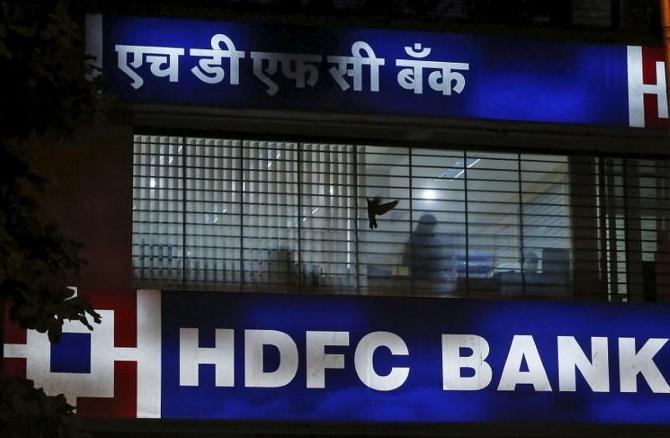Defying trends, the country’s largest private sector lender, HDFC Bank, has shifted its asset mix significantly towards high-rated segments.

As a result, its wholesale-to-retail mix has tilted heavily in favour of wholesale, even at the cost of margins.
Further, it is even looking to ramp up its branch network, with an aim to service clients within a 1-2 km radius rather than the current 5-6 km radius.
During Q4 of FY22, the bank added 563 branches while in the entire FY22, it added 734 branches, which is about two branches per day.
Further, it is looking to add another 150 branches within a short period of time.
“A branch in the catchment area can effectively manage the customer relationships better,” said Srinivasan Vaidyanathan, chief financial officer (CFO) in an analysts’ call.
During the fourth quarter, HDFC Bank added 7,167 to its headcount, and for the whole year, the figure was 21,486.
This is an all-time high.
“Our normal strategy is to ramp up branches, bring in new liability relationships, and the productivity of the branches from a deposit point of view should be best in class,” Vaidyanathan said.
The strategy to rapidly expand branch networks comes at a time when all other banks are going digital.
HDFC Bank has been at the forefront of digital transformation and is on course to launch products and services under Digital 2.0 plan after the regulator lifted the embargo on it last month.
The embargo was imposed by the Reserve Bank of India (RBI) in December 2020 after the bank’s mobile and internet banking platforms were hit by frequent outages.
Wholesale shift
From the pre-pandemic mix of 55:45 between retail and non-retail, HDFC Bank’s retail loan share has dropped to 39 per cent as on March 31, 2022.
Out of the remaining 61 per cent, 26 per cent is corporate loans and 35 per cent commercial and rural banking (except agriculture).
“Our asset mix has shifted towards higher-rated segments during the Covid period, albeit at lower yields.
"As a result, net interest income (NII) growth has been lower,” Vaidyanathan said.
“All through the pandemic, we saw growth in the retail segment was going down.
"Growth was picking up in the wholesale segment and the commercial and rural segments.
"In 2019, wholesale-to-retail mix was 45:55 and now things have reversed.
"So, retail has grown very well but wholesale has grown much faster.
"The high-rated segments tend to have low yields. Basically, we have traded off net interest margin (NIM) with operating cost and credit cost,” he added.
Analysts also noted that the emphasis towards the non-retail segment has been a drag on margins.
“HDFC Bank’s credit accretion in the recent past has been primarily led by wholesale and CRB, since credit standards were tightened in retail due to Covid. This has been a drag on margins,” broking firm Prabhudas Lilladher said in a note.
In the January-March quarter, the bank’s advances grew by 8.6 per cent sequentially and 20.8 per cent year-on-year (YoY).
In absolute numbers, advances of the lender went up by Rs 1.8 trillion in the quarter and Rs 2.26 trillion in the whole year.
This is largely led by the wholesale segment, which posted a growth of 11.6 per cent sequentially and over 17 per cent YoY.
The retail segment, however, lagged behind with a 5 per cent sequential growth and 15 per cent YoY growth.
Margin pressure
HDFC Bank, which reported a 23 per cent YoY growth in net profit to Rs 10,055.18 crore in the three months ended March 31, 2022, missed analysts' estimate.
Analysts were also unimpressed with 10.2 per cent growth in NII despite over 20 per cent YoY growth in advances.
Also, NIM of the lender stood at 4 per cent, a decline of 10-basis points sequentially.
This is perhaps the lowest margin the bank has reported in many quarters.
“NIM is not the only indicator of profitability because typically in the retail segment, NIMs may be higher but they come with higher operating and credit costs.
"If you are doing a lower margin business on the corporate side, which is highly rated, the operating cost and credit cost will be much lower than the retail business,” said Anil Gupta, vice-president & sector head of financial services rating at ICRA.
Within wholesale, the bank saw demand for loans coming from the telecom sector, public sector undertakings, the manufacturing sector to a certain extent, and non-banking financial companies.
Also, prepayments by corporate slowed down in the January-March quarter.
“We saw a tremendous amount of prepayments happen at the beginning of the financial year.
"The prepayments in this financial year were about Rs 65,000 crore.
"This quarter, we did not see as much prepayments or pay downs happening. So, two things contributed.
"There was some credit demand and the other thing was prepayments did not happen to the extent of the previous quarters,” Vaidyanathan said.
On the retail side, supply chain issues disrupted the vehicles business, which grew lower than the average.











